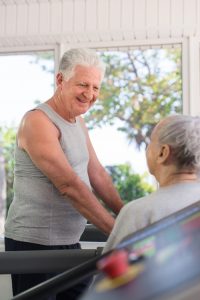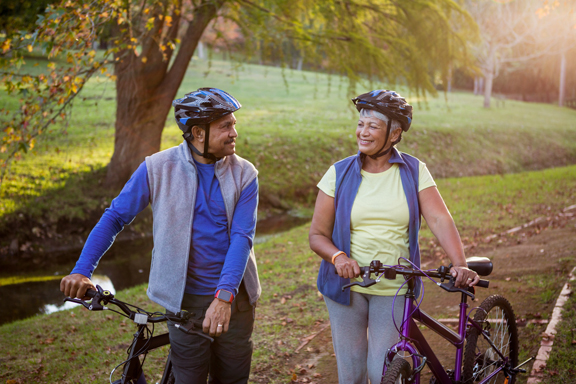Aging begins much earlier than many of us think: our minds and bodies start a slow but steady decline from our late 20s. This natural process, paired with the adoption of a sedentary lifestyle from a young age, means that aging accelerates in our adult years. The idea that we can start to become old “before our time” sounds illogical but because we are not moving and ‘stressing’ our bodies as they need to be, we are starting the aging process earlier than ever before in history. In order to get the years that we wish to have going forward, we need to act today instead of waiting for when physical problems develop as it will be too late!
Physical Aging

The reality of getting older is more than skin deep: it goes beyond hair turning grey, hair loss and the formation of wrinkles! Among other things, aging leads to height reduction due to spinal degeneration, reduced lean body mass and becoming less coordinated so balance becomes an issue. There are noticeable changes in the functioning of the cardiovascular, endocrine, respiratory and musculoskeletal muscles as well. Let’s look at some of these changes in more detail.
Maximal heart rate declines with age: this diminishes the accuracy of estimating training intensity based on heart rate. Even through exercise heart rate declines with age, in healthy older adults stroke volume has been shown to increase or be maintained. This is why I run hard during my workouts – to maintain my speed and power, but also to maintain my heart’s ability to pump oxygenated blood efficiently at any one level of intensity. It has worked over decades and as long as I remain injury free I can train at these levels into my 80’s. That is my bet.
Blood pressure rises with age: blood pressure determines many other physiological issues. The more unresolved stress plays a part in our daily lives, the more likely we are to live with higher blood pressure. This, paired with lack of adequate physical activity, can increase the risk of cardiac events including stroke and other debilitating outcomes. According to the American Heart Association, very often the “the first sign of trouble is sudden death”. This is a sobering thought. Many of us are living our lives with no clue that the risk of heart attack or stroke might be imminent. Exercise can help lower blood pressure.
Cholesterol increases with age: the issue of cholesterol is tied to increased risk of cardiac events. Three numbers are important: HDL (high density lipoproteins – “good” cholesterol), LDL (low density lipoproteins – “bad” cholesterol), and triglycerides (fatty acids that are transported by the blood). These are measured with standard blood tests and can be managed or brought into a healthy range by improved diet and exercise.
Skeletal muscle declines with age: this is particularly true if we are sedentary. For each decade after the age of 25, we lose 3-5% of muscle mass. This is primarily due to changes in lifestyle and the decreased use of the neuromuscular system. Strength gains can be made through resistance training programs that slow down muscular loss. I added strength training exercises to my running program in 1985 in order to maintain my muscle mass and be able to run into my later years. It was a critical decision at an important time in my life. I still do hard resistance training twice a week and this has allowed me to maintain my baseline strength and power. Gaining an understanding of the principles of resistance training will enable you to reduce muscle loss too. Therefore, it is important to add some form of resistance training to your physical activities in order to strengthen your muscles as early in life as possible because these protect our bones which become weak over time.
Decreased bone mass: With age the loss of calcium results in decreased bone mass and the best antidote (before going on medication) is weight bearing exercise that helps maintain bone mass. By the age of 90, as many as 32% of women and 17% of men will have sustained a hip fracture and of those many will die of related complications. Our joints are at risk of debilitating injury if we don’t maintain both muscle and bone mass. This is why a TOTAL training program is required if we are to be “successful agers”. I want all of you to become “successful agers”!
Conclusive thoughts
 Losing our ability to be independent and free of pain and chronic disease is something that none of us wants to endure. The thought that I could not take care of myself in the future drives my passion for fitness today. I am driven to be the best, the fastest, the strongest person I can be – mentally, physically, emotionally and spiritually. I have been diligent, consistent, and committed to my purpose of “being the example of the change I wish to see in the world”. I want my consciousness of life to be expansive – I never want to stop learning and growing. My idea of my life going forward from my 70th birthday is that the years ahead will be the best years of my life – that they will provide me the opportunity to be more, share more, have more of everything that life has to offer – all because I trained my entire life for this moment in time. You needn’t dread becoming old!
Losing our ability to be independent and free of pain and chronic disease is something that none of us wants to endure. The thought that I could not take care of myself in the future drives my passion for fitness today. I am driven to be the best, the fastest, the strongest person I can be – mentally, physically, emotionally and spiritually. I have been diligent, consistent, and committed to my purpose of “being the example of the change I wish to see in the world”. I want my consciousness of life to be expansive – I never want to stop learning and growing. My idea of my life going forward from my 70th birthday is that the years ahead will be the best years of my life – that they will provide me the opportunity to be more, share more, have more of everything that life has to offer – all because I trained my entire life for this moment in time. You needn’t dread becoming old!
The combination of these factors is the formula has worked for me so far – and it will work for you as well if you start as early in life as you can. Prepare your body for the years ahead and nothing can stop you from enjoying a long and healthy life. You too can approach your life in this way – starting today – by becoming PROACTIVE and not REACTIVE to your life’s journey.
10 tips from Nick to become proactive
- Take time to contemplate your current “mindset”: what thoughts you entertain, you become. If necessary, change your mindset.
- Decide what you want to achieve in your life and what kind of person you want to be, then work to achieve these aims. Think about what kind of legacy you want to leave behind. Build on that idea every day by taking action.
- Embrace the gift of life by affirming your commitment to your purpose.
- Pursue your dreams NOW. Don’t postpone them to tomorrow because tomorrow is not guaranteed to any of us. Today is the time to live your life fully! Treasure your time for what it is – precious! Never forget that time moves on whether we want it or not! Don’t waste a minute of your life on petty, non productive thought and activity.
- Don’t wait for a trip to the emergency room – get started today with a health and fitness plan right for you.
- Exercise your mind, heart, spirit and body daily so that they may work in harmony with each other and give you the best chance for joy and love – and fulfillment – that you can embody. Exercising all aspects of our self is the bridge to the future.
- If you are not a fitness buff, make sure you drink plenty of water, eat lots of greens and take a walk.
- Love and be kind to yourself – give yourself praise for your exercise efforts and a kind thought right when you need it. Listen to your body and be knowledgeable about yourself: be ready to learn from life.
- Take care of your body and eat wisely – your body will appreciate your thoughtfulness.
- Finally, fall in love with fitness and be passionate about training your body.
Originally printed on HealthyNewAge.com. Reprinted with permission from Nicholas Prukop.
Nicholas Prukop is an ACE Certified Personal Trainer & a Health Coach, a fitness professional with over 25 years of experience whose passion for health and fitness comes from his boyhood in Hawaii where he grew up a swimmer on Maui. He found his calling in writing his first book “Healthy Aging & You: Your Journey to Becoming Happy, Healthy & Fit” and since then he has dedicated himself to empowering, inspiring and enabling people of all ages to reach for the best that is within them and become who they are meant to be – happy, healthy and fit – and be a part of a world where each person can contribute their own unique gifts to life.
If you need help in designing a fitness plan, you can contact Nicholas Prukop via email at runningnick@sbcglobal.net or read his inspiring book Healthy Aging & YOU

